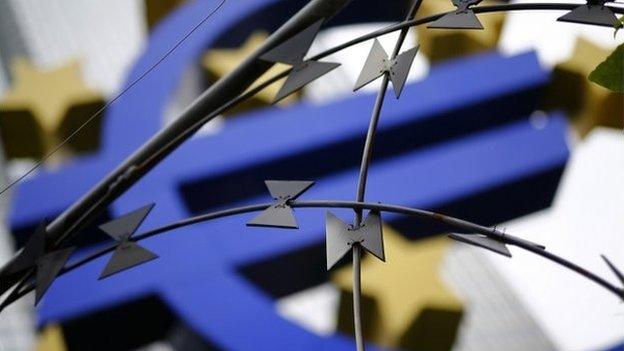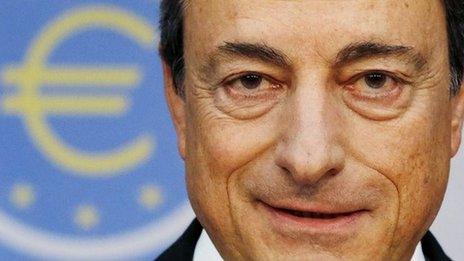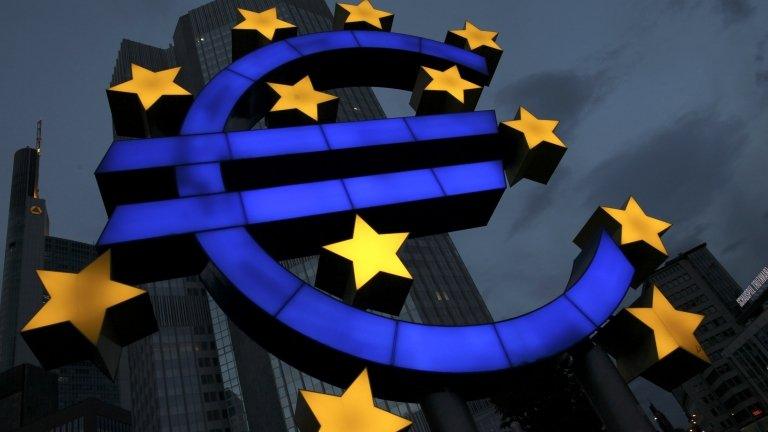ECB eurozone action: Will it work?
- Published

Options to kick-start eurozone recovery are slowly being closed off
Further action to avert the eurozone's economic decline had been expected - just not quite so soon.
If the timing of the European Central Bank's latest rescue measures tell us anything, it's that things in the 18-country euro bloc are getting worse.
Words such as "dramatic" and "startling" were used by the commentators to describe Thursday's news of a further cut in ECB interest rates and a huge private sector bond-buying programme.
It was thought that previous ECB measures to avoid stagnation in the eurozone would be given more time to work. They clearly are not.
"The swiftness of the move is surprising as certain elements of June's measures only just came into effect this month - it was thought the ECB would wait to see their effect," said Alasdair Cavalla, economist at the Centre for Economics and Business Research
"August's news on the severity of the economic situation therefore appears to have convinced the ECB that more will be necessary, whatever the outcome," he said.
The bloc's problems were underlined on Friday, with official figures from the Eurostat statistics agency confirming that eurozone growth in the second quarter of this year was flat.
Cut forecasts
"The second quarter stagnation... clearly added to the pressure on the ECB to take further stimulative action sooner rather than later to try and dilute the risk of extended low consumer price inflation morphing into deflation," said economist Howard Archer at IHS Global Insight.
It all "reinforces concern over the underlying health and lack of competitiveness" in the eurozone, he said.
Just to ram home the challenges ahead, the ECB on Thursday also cut forecasts for growth in the euro area this year and next.

Economic crises in Greece or Ireland used to trouble policymakers, but now France and Italy are the main worries
Business investment is falling, according to Eurostat data. And high public debt is still a big issue for some eurozone countries.
Meanwhile, low inflation threatens to turn into stagnation, with consumers putting off spending as they wait for prices to fall further.
Unemployment remains a big problem. With the eurozone jobless rate at 11.5%, it is only fractionally down on the 12% peak reached last summer.
All this is making investors risk averse. Some are even buying government debt knowing that they will possibly lose money.
Yields on two-year bonds in Germany, Ireland, the Netherlands and some other countries have turned negative. That means that investors are effectively paying to lend their money to those countries.
But banks would rather park their cash in these securities than seek out other investment opportunities.
'Aggressive approach'
Yet, the ECB hopes that its stimulus will eventually get businesses and individuals spending, and in particular bring down the value of the euro to boost exports.
"Perhaps the main immediate benefit of the additional policy action is a weakening of the exchange rate," said Chris Williamson, chief economist at Markit. "The lower exchange rate will undoubtedly provide a boost to exporters' competitiveness.
"The action should also help improve business and consumer confidence. The more determined and aggressive approach from the ECB should hopefully encourage more investment and spending."
Yet, the fear remains that, having averted meltdown and the break-up of the euro during the financial crisis, the eurozone now faces a prolonged period of anaemic growth.
ECB president Mario Draghi has made it clear that central bank action alone cannot be sufficient to halt economic decline. Governments must continue reforms, he said.
"We can provide as much monetary stimulus as we want, as much availability of credit as we want, but if the person who has planned to use this credit for a new business has to wait eight months before he or she can open this new business, and then once she does it, she has to pay lots of taxes, then she will not apply for credit," said Mr Draghi on Thursday.
But repealing labour regulations, cutting taxes and improving the business climate has been slow in many countries.
France's economy is on the slide, but president Francois Hollande is facing a political backlash for tax cuts for businesses and cuts in government spending.
'Grim outlook'
In debt-laden Italy, attempts to overhaul the economy have ground to a halt, along with business investment.
Marc Ostwald, market strategist at ADM Investor Services, was blunt in his assessment when he said that without economic reform, no amount of ECB action would change the "grim outlook".

Will ECB president Mario Draghi's next step be quantitative easing? Many now think so
He said: "France and Italy's woeful economic performance makes the need for reform extremely acute, even if there is scant historical evidence to expect any meaningful progress."
Of the three big eurozone economies, only in Germany do the clouds appear to be lifting.
Official figures on Friday showed a strong rise in industrial production in July, adding to other recent data suggesting that the eurozone's economic driving force is getting back on track, after a 02% contraction in the second quarter.
But, said Andreas Rees, economist at UniCredit: "The latest increase in overall industrial activity impressively confirms that a rebound in the German economy in the third quarter is under way. In the third quarter, growth will return."
A rebound in the German economy will hopefully drag others along in its wake. But not everyone is convinced of a speedy recovery in the eurozone's economic powerhouse
Adding to the eurozone's woes are increasing geo-political tensions over Ukraine and Russia, important trading partners for Germany.
"[Germany's] strong start in the third quarter limits further downside risks, but the short-term outlook for Germany's industry is overshadowed by the Ukraine risk," said Berenberg Bank economist Christian Schulz.
Print money?
If Thursday's measures don't work, can the ECB do much more? Although its armoury is depleted, there is one big gun that's not yet been used.
The bank could create new money to buy sackfuls of government bonds - so-called full-blown quantitative easing (QE).
It's an option of last resort, and not a path that the ECB - nor Germany - wants to go down. One risk of printing money is that it might take the pressure off the very government's that Mr Draghi and Germany's Angela Merkel want to impose radical economic reform.
But even the experts who thought the ECB would not go down this route are revising their opinions.
Stephanie Flanders, chief market strategist at JP Morgan Asset Management, said: "I have always felt that the bar to full-blown quantitative easing by the ECB was extremely high, but listening to Draghi's comments about the latest trends in the real economy and, especially, the inflation data, it is hard to avoid the conclusion that they are heading quite fast in that direction."
Persistent low inflation, "along with the loss of momentum in the European economy, has brought the prospect of full-scale quantitative easing a great deal closer," she said.
Of course, there's no guarantee that even QE can cure the eurozone's ills. Where policymakers would go after is anyone's guess.
- Published4 September 2014
- Published4 September 2014
